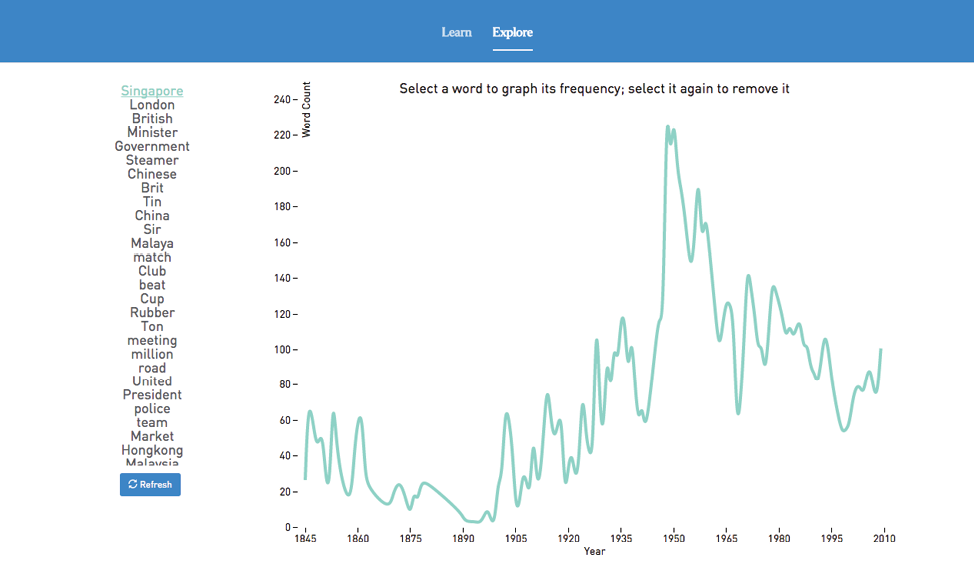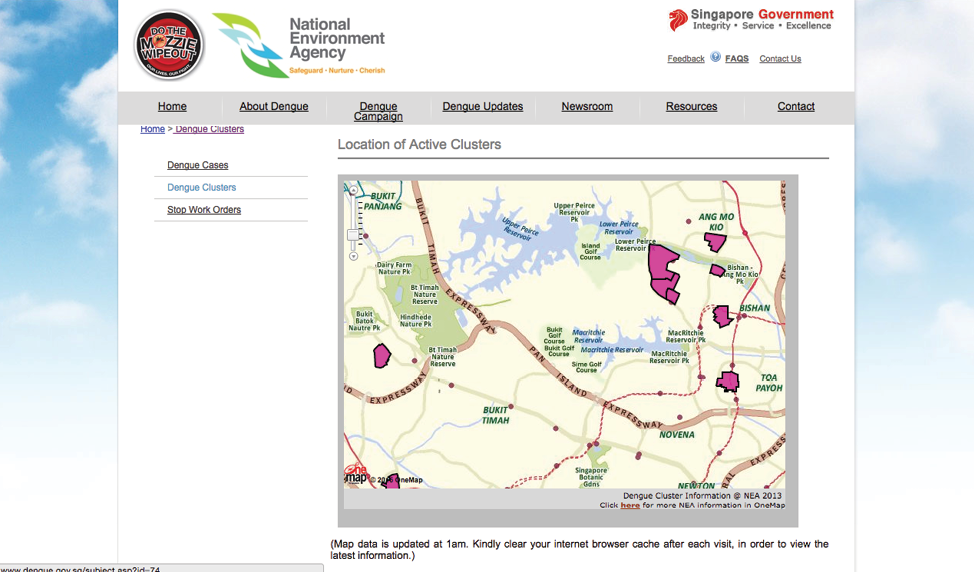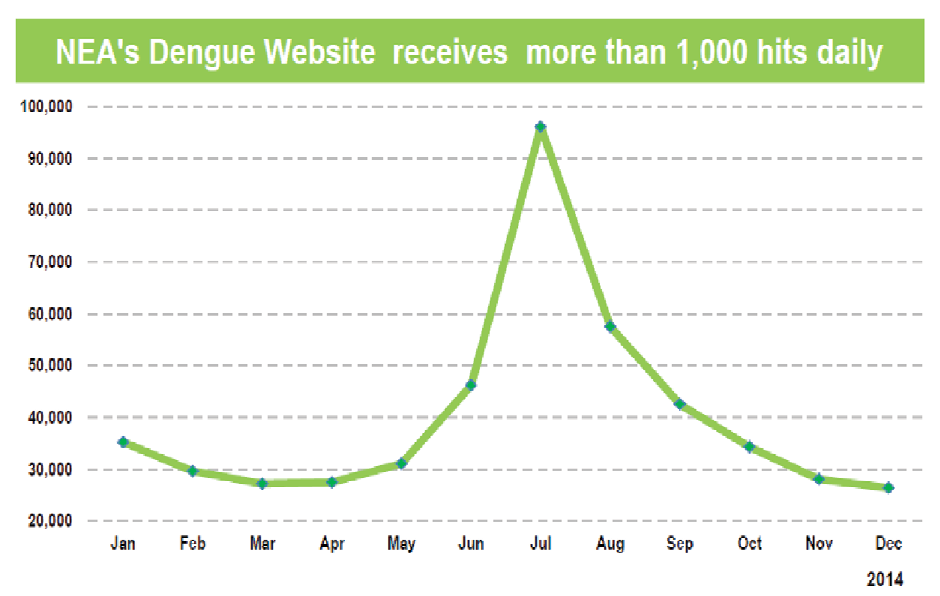The Global Impact of Open Data
Singapore's Dengue Cluster Map
Open Data for Public Health
by Andrew Young, David Sangokoya and Stefaan Verhulst*
Reference
1 Special thanks to Akash Kapur who provided crucial editorial support for this case study, and to the peer reviewers [odimpact.org/about] who provided input on a pre-published draft.
2 “Dengue.” World Health Organization. http://www.who.int/topics/dengue/en/.
3 Associated Press. “Singapore on alert after dengue fever cases rise.” The Independent. June 11, 2013. http://www.independent.co.uk/life-style/health-and-families/health-news/singapore-on-alert-after-dengue-fever-cases-rise-8654478.html.
4 “Dengue.” World Health Organization. http://www.who.int/topics/dengue/en/.
5 “Dengue and Climate.” Centers for Disease Control and Prevention. http://www.cdc.gov/Dengue/entomologyEcology/climate.html.
6 A serotype is a “group of intimately related microorganisms distinguished by a common set of antigens.” Merriam-Webster Medical Dictionary. http://www.merriam-webster.com/medical/serotype.
7 “Host Response to the Dengue Virus.” Scitable by Nature Education. http://www.nature.com/sqcitable/topicpage/host-response-to-the-dengue-virus-22402106.
8 Wong, Chun Han. “Dengue Fever on the Rise in Singapore.” The Wall Street Journal. April 29, 2013. http://www.wsj.com/articles/SB10001424127887324743704578446162122159222.
9 Wong, Chun Han. “Dengue Fever on the Rise in Singapore.” The Wall Street Journal. April 29, 2013. http://www.wsj.com/articles/SB10001424127887324743704578446162122159222.
10 GovLab Interview with the National Environment Agency of Singapore, July 23, 2015.
11 “Fact Sheet on Managing Singapore’s Dengue Outbreak.” National Environment Agency of Singapore. March 11, 2014. http://www.nea.gov.sg/docs/default-source/corporate/COS-2014/managing-singapore’s-dengue-outbreak.pdf.
12 According to the World Bank, Singapore had a population density of 7,814 people per square kilometer in 2014, making it the third-densest country in the world. Source: “Population density (people per sq. km of land area).” World Bank Data. http://data.worldbank.org/indicator/EN.POP.DNST?order=wbapi_data_value_2014+wbapi_data_value+wbapi_data_value-last&sort=desc.
13 GovLab Interview with the National Environment Agency of Singapore, January 22, 2016.
14 GovLab Interview with the National Environment Agency of Singapore, July 23, 2015.
15 Tiong, Sabrina. “NEA officers fanning out in dengue hot spots.” AsiaOne. March 31, 2013.
16 GovLab Interview with the National Environment Agency of Singapore, July 23, 2015.
17 https://www.facebook.com/Stop.Dengue.Now?fref=ts
19 Centre for Strategic Futures. “Foresight.” 2014. http://www.csf.gov.sg/docs/default-source/default-document-library/csf-report-2014.pdf.
20 Kuah, Adrian W.J. and Lim Seok Hui. “After Our Singapore Conversation: The Futures of Governance.” Singapore Civil Service College. June 2014. https://www.cscollege.gov.sg/Knowledge/ethos/Ethos%20-%20Issue%2013,%20June%202014/Pages/After%20Our%20Singapore%20Conversation%20The%20Futures%20of%20Governance.aspx.
21 Wei, Leong Ming. “Developing Talents in Futures.” in Foresight. 2014. http://www.csf.gov.sg/docs/default-source/default-document-library/csf-report-2014.pdf.
25 http://singaporenews.github.io/
26 GovLab interview with Professor Ee-Peng Lim, Ph.D., Co-Director, Living Analytics Research Centre, Singapore Management University, September 28, 2015.
27 GovLab Interview with the National Environment Agency of Singapore, July 23, 2015.
28 The NEA defines a dengue cluster as “a locality with active transmission where intervention is targeted. It is formed when two or more cases have onset within 14 days and are located within 150m of each other (based on residential and workplace addresses as well as movement history).” GovLab Interview with the National Environment Agency of Singapore, July 23, 2015.
29 Under the Infectious Diseases Act, Cap. 137, every medical practitioner is required to notify the Director of Medical Services (Ministry of Health) not later than 24 hours from the time of diagnosis of dengue fever/dengue haemorrhagic fever.
30 GovLab Interview with the National Environment Agency of Singapore, August 31, 2015.
31 GovLab Interview with the National Environment Agency of Singapore, July 23, 2015.
32 GovLab Interview with the National Environment Agency of Singapore, August 31, 2015.
33 GovLab Interview with the National Environment Agency of Singapore, July 23, 2015.
34 GovLab Interview with the National Environment Agency of Singapore, August 31, 2015.
35 GovLab Interview with the National Environment Agency of Singapore, July 23, 2015.
36 GovLab Interview with the National Environment Agency of Singapore, July 23, 2015.
37 “Dengue on the Rise – Some Apps to Stay Informed on Dengue Clusters.” Iheartapple. http://iheartapple.com/2013/01/dengue-on-the-rise-some-apps-to-stay-informed-on-dengue-clusters/.
39 GovLab Interview with the National Environment Agency of Singapore, July 23, 2015.
40 GovLab interview with Professor Ee-Peng Lim, Ph.D., Co-Director, Living Analytics Research Centre, Singapore Management University, September 28, 2015.
41 GovLab Interview with the National Environment Agency of Singapore, July 23, 2015.
42 Xu, Terry. “App site tracks dengue cases in Singapore using Google Maps.” The Online Citizen. July 30, 2014. http://www.theonlinecitizen.com/2014/07/app-site-tracks-dengue-cases-in-singapore-using-google-maps/
43 Xu, Terry. “App site tracks dengue cases in Singapore using Google Maps.” The Online Citizen. July 30, 2014. http://www.theonlinecitizen.com/2014/07/app-site-tracks-dengue-cases-in-singapore-using-google-maps/
44 GovLab Interview with the National Environment Agency of Singapore, July 23, 2015.
46 “Potential dengue vaccine protects those aged 9 and above: Study.” Your Health Asia One. August 4, 2015. http://yourhealth.asiaone.com/content/potential-dengue-vaccine-protects-those-aged-9-and-above-study





